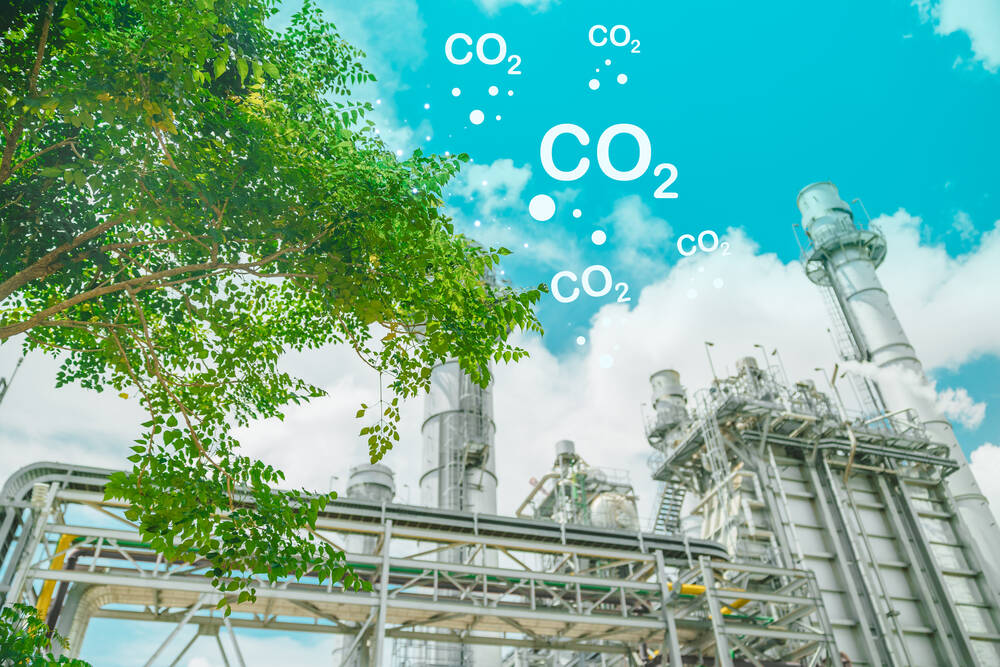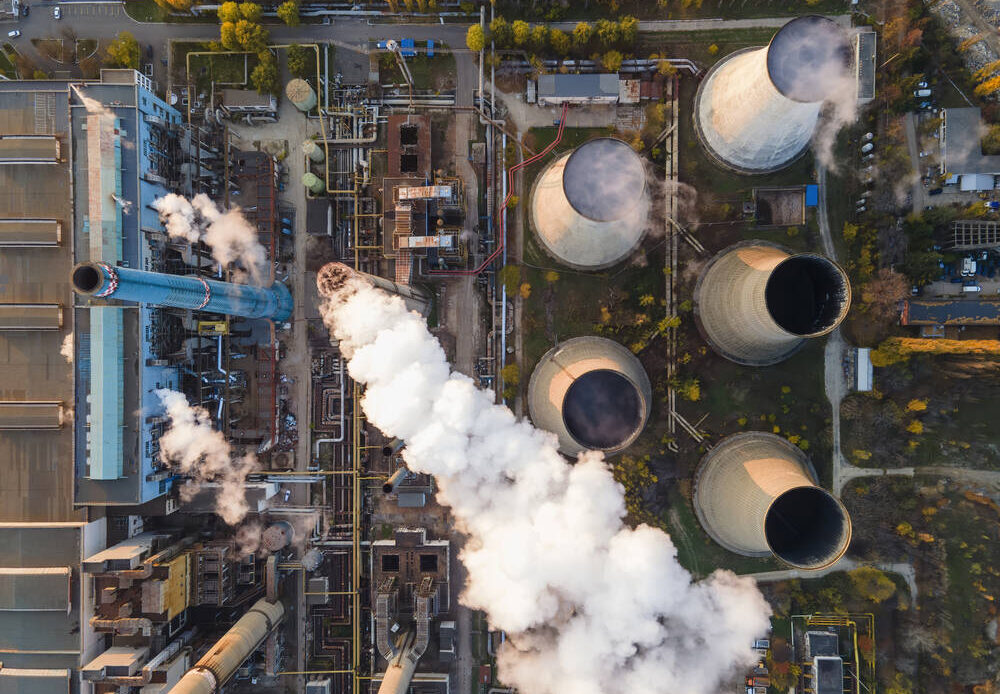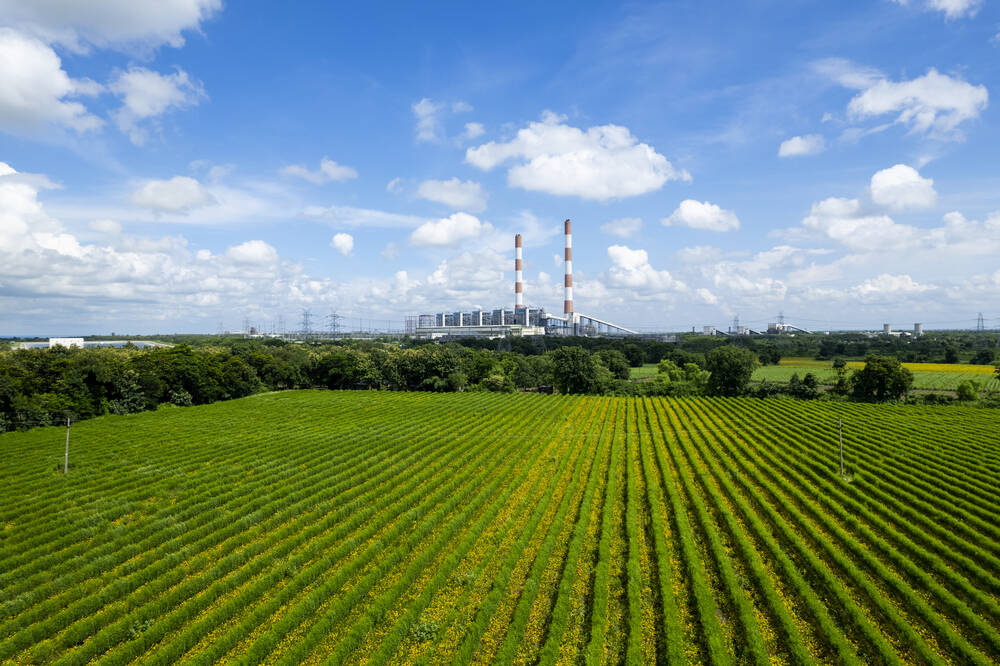Key Takeaways:
- Absorbing up to 90% of CO₂ emissions, carbon capture and storage could make emission-heavy industries far more sustainable.
- Hard-to-decarbonise sectors like fertiliser, cement, and steel should only continue if technologies like carbon capture and storage are fully in place.
- A lack of time, infrastructure, and funding remains the biggest barrier to developing carbon capture and storage at scale.
- Public distrust grows from limited awareness, with many seeing carbon capture and storage as greenwashing for polluting industries.
- Alongside other climate tools, carbon capture and storage could be transformative, but it’s not yet ready to drive jobs, innovation, or the green transition alone.
As climate change accelerates, carbon capture technology is gaining traction as a way of reducing emissions from heavy industrial processes.
By capturing carbon dioxide before it’s released into the atmosphere and transporting it to sites for long-term carbon storage, carbon capture and storage could help prevent millions of tonnes of carbon emissions per year.
From natural gas facilities to large-scale carbon capture projects, the solution’s potential is vast, but not without challenges. We delve into the pros and cons of Carbon Capture and Storage (CCS), and why it could be a key tool in facing global warming, but public trust and transparency are crucial.
Advantages of Carbon Capture and Storage
Carbon Capture and Storage (CCS) is an emerging sector of climate tech that prevents carbon from going into the atmosphere and damaging the environment.
The idea was born in the 1970s for enhanced oil recovery, and has come a long way. While there are dozens of variations of carbon capture, CCS is the most established as it is well-matured, developed and tested across various sectors.
Captured CO₂ is usually stored in deep geological formations, underground saline aquifers, or even unmineable coal seams.
CCS roots back to the 1970s and developed into a growing climate strategy in the 1990s, with the 1996 Sleipner project in Norway now storing around 1 million tonnes of CO₂ a year.
Here are the many benefits of carbon capture and storage and why it is now a key part of global climate strategy.
Reduces Greenhouse Gas Emissions

Carbon capture and storage (CCS) reduces greenhouse gas emissions by trapping CO₂ before it escapes into the air. Instead of heating up the atmosphere, the carbon is transported and stored deep underground.
This typically happens at high-emitting sites like power stations, cement works, and chemical plants. Before CCS, these industries released huge volumes of CO₂. With it, up to 90% of emissions can be captured at the source.
In the UK, major projects like HyNet in North West England and Net Zero Teesside in the North East aim to adopt CCS by the late 2020s, joining a wave of international energy efforts to scale carbon capture. Currently, the groundwork is being established between infrastructure, regulation, funding, and cluster development.
Supports Hard-to-Decarbonise Industries
CCS can immensely reduce emissions in hard-to-decarbonise industries where the emissions are built into the process itself, such as:
- Steel production – Huge industrial sites produce steel with blast and oxygen furnaces, with masses of CO₂ emitted when iron ore turns into steel. Instead of being released through the chimneys, the gases are captured in CSS
- Cement manufacturing – Large-scale cement plants release CO₂ when turning limestone into clinker, whereas CCS captures directly from the exhaust of the kiln
- Fertiliser production – In chemical fertiliser plants, CO₂ is emitted when hydrogen is made during ammonia production. The CCS is placed at the flue gas stack after this stage, capturing pure CO₂.
Contributes to Net Zero Carbon
Carbon capture and storage contributes to net zero targets by capturing CO₂ at the source.
Whether a building, business, or entire country, CCS can hugely help in meeting net zero targets.
It’s a potentially transformative solution for emissions that are unavoidable, allowing essential processes to continue with only a fraction of their emissions entering the atmosphere.
Enables Negative Emissions Technologies
By giving the emissions a place to be permanently stored, CCS enables a broad range of negative-emission tech, including:
- BECCS (Bioenergy with Carbon Capture and Storage) – Biomass is burned for energy, releasing the plants’ absorbed CO₂, however storing it permanently
- DAC (Direct Air Capture) – DAC systems take in CO₂ from the air, and CCS offers a place to store it
- Biochar – Forms when plant waste is heated with low oxygen, and CCS captures any CO₂ released during, making it a negative emissions process.
Creates Jobs in Emerging Sectors
If CCS rolls out to the UK and becomes widely used, it will open a huge array of job opportunities, such as:
- Process engineer – Optimising the CO₂-capturing systems at industrial facilities.
- Pipeline Technician – Managing the complex systems of pipes that allow for the transportation of liquid.
- Environmental Risk Analyst – Determining the potential risks of the underground storage over time, or assessing how there could be leaks.
Extends the Use of Existing Infrastructure
Capturing up to 90% of emissions, CCS allows certain high-emitting facilities to stay in operation rather than being closed for environmental reasons. This means that ranges of infrastructure keep running instead of being retrofitted, such as:
- Fossil fuel power stations – While many have been shut down and replaced with renewables, CCS does allow some plants to run longer
- Oil and gas pipelines – Phased out for cleaner energy, unused pipes can be repurposed for transporting carbon captured in CSS
- Depleted oil and gas fields – No longer producing fossil fuels, these underground reservoirs can be used to store captured CO₂ safely and permanently.
Attracts Investment in Clean Technologies
CCS attracts funding into the clean technology sector, requiring new infrastructure such as storage facilities, capture units and pipelines.
Investors are increasingly confident backing hard-to-decarbonise industries as CCS allows them to operate sustainably and meet targets.
Many carbon credit schemes are linked to CSS projects, encouraging direct investment in developing clean technologies.
Enhances Energy Security
CCS aids security by making low-carbon energy sources more resilient and reliable, extending the infrastructure’s value and supporting the transition away from fossil fuels.
For instance, Net Zero Teesside is a gas power station in the UK that utilises CSS to ensure practices remain low-carbon. Instead of using depleting, harmful fossil fuel sources, CSS allows for long-term solutions to develop.
Promotes Innovation and R&D
CCS promotes innovation in cleaner technologies by offering a scalable, long-term solution to emissions that has driven decades of testing, learning, and knowledge. This involves:
- New carbon capture materials – Metal-Organic Frameworks absorb CO₂ like a sponge, new amine-based solvents are used in CSS plants, or solid sorbents capture CO₂ in a solid form
- New leak detection or tracking tools – Including smart well systems or subsurface monitoring sensors (GE and Schlumberger); new tech must be developed to prevent risks
- New chemical processes – Innovations like carbonate looping or cryogenic separation allow CO₂ to be captured more efficiently in different industrial settings.
Offers a Transitional Climate Solution
CSS poses a great transitional solution as we phase out fossil fuels, allowing them to continue running with CCS to ensure a stable energy supply while renewables and cleaner solutions are being established.
CCS offers a practical, cost-effective way to retrofit existing plants instead of demolishing infrastructure.

Disadvantages of Carbon Capture and Storage
While CCS possesses a range of advantages from new green jobs to innovation, it also comes with some stubborn challenges.
As with any new technology, it can take significant time, effort, infrastructure, and investment to become an accessible solution. Carbon capture and storage has been in development for a few decades, but is still far from being rolled out to every heavy-emitting sector.
Below are the main disadvantages that CCS is facing, which will hopefully ease over time so that the solution can help us accelerate the green transition.
High Implementation and Operating Costs
Currently, carbon capture and storage is very costly from initial building fees to the ongoing maintenance costs.
High upfront costs make CCS inaccessible today, though like solar panels, these costs are expected to fall over time.
Beyond this, the transport costs, maintenance fees for storage wells, pipelines, and compressors add towards a hefty sum, making CCS not yet readily available.
Energy Intensive Process
CCS reduces power plant efficiency due to its high energy demands.
For instance, Boundary Dam saw power output drop after adding CCS. Some systems, like Petra Nova, needed an extra gas turbine just to power the process. This added energy demand can offset some of the climate benefits.
Potential for CO₂ Leakage
CSS relies entirely on the underground, long-term storage of carbon; however this can’t always be 100% guaranteed.
Storage facilities must be meticulously monitored to prevent leaks from old or faulty wells.
CCS’s long-term stability is being researched, with decades needed to accurately test its livelihood over longer periods of time.
Public Opposition and Perception Issues
CCS has faced perception issues since early on, with lacks of understanding contributing towards some broad concerns, such as:
- Doubts of safety – Concerns arise around CO₂ leaks disrupting human health or the environment
- Not in my backyard – People not wanting injection sites, industrial facilities, and huge pipelines near homes
- Scepticism – CCS led by untrusted fossil fuel companies can be believed to be for PR or self-serving.
Risk of Lock-In to Fossil Fuels
In the shift to truly clean energy sources, CCS makes the phased-out fossil fuel plants less emissions-heavy, however risks slowing their true retirement.
Instead of investing in true, clear sources like wind or solar, funding is channelled into expensive pipelines or developing the tech.
Moreover, a few critics argue that CCS is greenwashing the heavy emitters and giving a clean label to dirty industries.
But in the case that 90% of the emissions are captured, is it still “dirty”?
Limited Storage Capacity
CCS poses an issue of limited storage space underground, as there are only so many places meeting its exact geological requirements (porous rock, cap rocks, and certain depth/pressures).
Around the world, it’s safe to say there aren’t enough sites to match global climate goals, plus every process can take years of approval and planning. In combination with other strategies, however, CCS could be an effective part of a broader climate strategy.
Underdeveloped Infrastructure
CCS requires a vast physical network from initial capture units to extensive compression facilities.
The infrastructure for a single processing system could take several years and billions of pounds to create.
Because of this, very few CO₂ pipelines currently exist, with the UK only planning its first networks now.
Until this network is built out, CCS cannot operate at a meaningful scale.
Uncertain Long-Term Effectiveness
CCS’s value is permanently storing carbon, but its permanence cannot be 100% guaranteed.
Projects plan for the carbon to be stored for hundreds to thousands of years, but the longest we’ve reached is Sleipner’s project at 29 years.
Only a tiny leak of 1% could make the CCS project much less effective, meaning there are very real risks if systems aren’t properly stress-tested to simulate long-term conditions.
Diverts Focus from Renewable Energy
Focusing on CCS might reduce the urgency needed for true renewables like wind and solar, which can be harnessed in perpetuity to generate energy.
CSS only works for heavy-emitting industries which are without a doubt being phased out over the next couple of decades. Critics, then, argue that CCS is useful for the transitional period, but clean energy should receive the majority of investment and long-term policy support.
Questionable Commercial Viability
With the technology far from fully developed, CCS’s high costs and commercial uncertainty have made many projects too risky, leading to cancellations or outright failures.
These projects often rely on public subsidies and taxpayer support to fund long construction timelines with no guaranteed return, costly storage development, custom retrofits, and specialised equipment.
This can amount to billion dollar totals; a project in Mississippi was cancelled even after up to £7.5 billion dollars invested.
FAQs
What is Carbon Capture and Storage (CCS)?
CCS is a low carbon technology that has been developing for a few decades, promising up to 90% of emissions captured at heavy-emitting sites. While promising, it still faces major challenges before it can be widely adopted.
How does CCS work?
CCS works by placing capture equipment near chimneys at power plants and industrial facilities. It traps most of the CO₂ emissions before they can escape into the atmosphere.
Where is the CO₂ stored?
Captured CO₂ is stored underground in deep geological formations, such as saline aquifers or depleted oil and gas fields. It’s intended to stay there for hundreds to thousands of years, though its long-term reliability is still being tested.
Is CCS a proven technology?
Large-scale projects like Sleipner in the North Sea have successfully stored CO₂ since 1996. But while the technology is proven, it hasn’t yet been deployed widely enough to count as a mainstream climate solution.
More Information
https://www.netzeroinvestor.net/news-and-views/can-carbon-capture-be-a-good-investment
https://www.gov.uk/government/news/major-carbon-capture-project-to-deliver-jobs-and-growth
https://www.iea.org/commentaries/is-carbon-capture-too-expensive
https://www.sciencedirect.com/science/article/abs/pii/S0012825218304264

